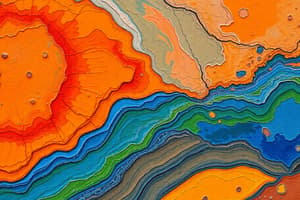Podcast
Questions and Answers
What is the primary process responsible for the downslope transport of soil and rock material?
What is the primary process responsible for the downslope transport of soil and rock material?
- Gravitational body stresses (correct)
- Wind erosion
- Chemical weathering
- Mechanical weathering
Which type of deposition describes sediments deposited at the base of hillslopes?
Which type of deposition describes sediments deposited at the base of hillslopes?
- Glacial
- Alluvial
- Aeolian
- Colluvial (correct)
Weathering of softer materials can occur over what timescale?
Weathering of softer materials can occur over what timescale?
- Thousands of years
- A few months
- Decades
- A few years (correct)
What type of weathering is characterized by the breakdown of rocks at the site where they are found?
What type of weathering is characterized by the breakdown of rocks at the site where they are found?
Which of the following processes can lead to rapid erosion?
Which of the following processes can lead to rapid erosion?
What natural process created the sea stacks known as the Twelve Apostles?
What natural process created the sea stacks known as the Twelve Apostles?
Which type of mass wasting occurs when soil or rock rapidly moves downhill due to heavy rainfall?
Which type of mass wasting occurs when soil or rock rapidly moves downhill due to heavy rainfall?
What characterizes the creep type of mass wasting?
What characterizes the creep type of mass wasting?
Which type of mass wasting involves the complex lateral movement of earth materials?
Which type of mass wasting involves the complex lateral movement of earth materials?
Which of the following types of mass wasting typically involves thick unconsolidated deposits?
Which of the following types of mass wasting typically involves thick unconsolidated deposits?
What factor primarily differentiates the various types of mass wasting?
What factor primarily differentiates the various types of mass wasting?
What causes flow mass wasting to happen rapidly?
What causes flow mass wasting to happen rapidly?
What is the primary difference between mechanical and chemical weathering?
What is the primary difference between mechanical and chemical weathering?
In a topple failure, what kind of movement occurs?
In a topple failure, what kind of movement occurs?
Which of the following is an example of biological weathering?
Which of the following is an example of biological weathering?
Which exogenic process involves the transportation of soil and rocks?
Which exogenic process involves the transportation of soil and rocks?
What primarily drives exogenic processes such as weathering and erosion?
What primarily drives exogenic processes such as weathering and erosion?
Which of the following scenarios best illustrates mechanical weathering?
Which of the following scenarios best illustrates mechanical weathering?
What role does deposition play in the exogenic processes?
What role does deposition play in the exogenic processes?
How does chemical weathering alter rocks and minerals?
How does chemical weathering alter rocks and minerals?
What is the primary outcome of weathering in terms of Earth's landscapes?
What is the primary outcome of weathering in terms of Earth's landscapes?
Flashcards are hidden until you start studying
Study Notes
Exogenic Processes
- Exogenic processes occur on Earth’s surface, primarily reducing relief through weathering, erosion, transport, and deposition.
- Major agents driving exogenic processes include water, ice, and wind.
Weathering
- Weathering involves breaking down or wearing away rocks, soil, and minerals by natural elements over time.
- Essential for shaping landscapes, the process can take many years.
Types of Weathering
- Mechanical Weathering: Physical breakdown of rocks without altering their chemical composition.
- Chemical Weathering: Changes the composition and structure of rocks through chemical reactions.
- Biological Weathering: Involves the breakdown of rocks through the activities of organisms, including plants and burrowing animals.
Erosion
- Erosion is the process where natural forces such as wind, water, or ice transport rocks, soil, and other materials on the Earth's surface.
- Materials can be deposited in new locations after being eroded.
Real-life Erosion Examples
- The Twelve Apostles (Victoria, Australia): Ocean waves and winds have carved limestone cliffs into sea stacks.
- Nitmiluk National Park (Northern Territory): The Katherine River has formed a deep gorge over millions of years.
Mass Wasting
- Mass wasting refers to the bulk displacement of soils and rocks downslope due to gravity.
- Different types include:
- Creep: Slow, gradual downward movement of the ground.
- Fall: Occurs on steep, nearly vertical slopes.
- Slide: Sudden movement of soil or rock downhill, often triggered by heavy rainfall (includes landslides, rockslides, and mudslides).
- Flow: Rapid movement of waterlogged soil particles, commonly after heavy rainfall.
- Slump: A type of slide within thick, unconsolidated deposits.
- Spread: Lateral movement of cohesive materials over a weaker substrate.
- Topple: Involves forward rotation and movement of materials out of a slope.
Deposition
- Deposition refers to the dislodgement and downhill transport of soil and rock material due to gravitational stresses.
- Types of Deposition:
- Colluvium: Loose sediments deposited at the base of hillslopes by processes like rain wash and sheetwash.
- Alluvial: Sediments like clay, silt, sand, or gravel deposited by running water in various settings like stream beds or floodplains.
Race Against Time
- Weathering can take from a few years for softer materials to millions of years for harder rocks like granite.
- Erosion can happen rapidly, especially during storms, or gradually over extended periods due to ongoing processes like wind and water action.
Summary of Concepts
- Weathering: Breakdown of rocks and minerals in situ.
- Erosion: Transporting of weathered materials from one location to another.
- Weathering types include mechanical, chemical, and biological, each with distinct processes and effects.
Studying That Suits You
Use AI to generate personalized quizzes and flashcards to suit your learning preferences.




